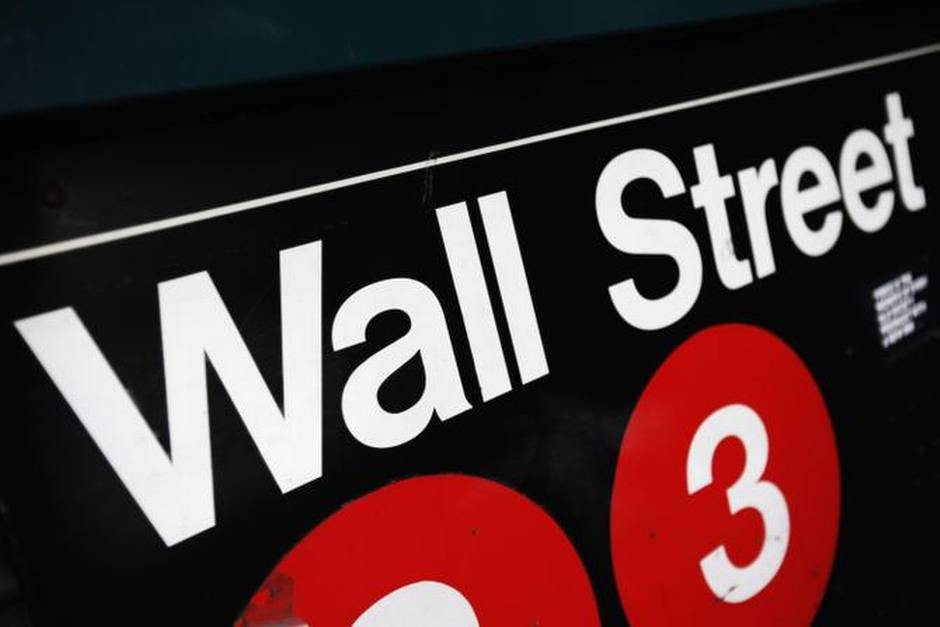Weak Earnings Results Drive Slight Decline on Wall Street
Post on: 5 Май, 2015 No Comment

About
Richard Drew, AP By MATTHEW CRAFT
NEW YORK — Disappointing earnings results weighed on the stock market in morning trading on Thursday, following two steep drops this week.
Shortly after 11:30 a.m. the Dow Jones industrial average was off 46 points at 14,572, a decline of 0.3 percent. The Dow lost 138 points the day before and is down 2 percent for the week.
Morgan Stanley, Pepsi and others joined in the parade of companies turning in quarterly results Thursday. Morgan Stanley sank 5 percent to $20.47 after reporting a drop in earnings and revenue. It made less money from trading bonds and commodities, a common theme for many investment banks.
Ebay’s stock sank 5 percent to $53.38 after the online auction company cut its forecast for profits in the current quarter.
Verizon, Pepsi and Union Pacific surged after reporting quarterly results. Verizon Communications’ profits beat analysts’ predictions as wireless revenue kept rising at a rate that’s the envy of the industry. Profits and sales for Pepsi also surpassed estimates. Verizon’s stock gained 3 percent to $51.09, while Pepsi climbed 5 percent to $82.78.
Higher shipping rates pushed Union Pacific’s profit up 11 percent, and the railroad said it expects shipping to pick up later this year. Union Pacific rose 4 percent to $142.11.
After the closing bell, the tech sector weighs in with earnings from IBM, Google and Microsoft.
The market didn’t get any help from economic news early Thursday.
The Labor Department reported that the number of Americans seeking unemployment benefits increased 4,000 last week to 352,000. The slight gain suggests that the sluggish hiring seen in March may not last. Applications are a proxy for layoffs.
Also, the Philadelphia branch of the Federal Reserve reported a slowdown in manufacturing in the mid-Atlantic region. The survey was weaker than economists had been expecting.
In other trading, the Standard & Poor’s 500 index fell five points, or 0.3 percent, to 1,547. The Nasdaq composite fell 21 points, or 0.6 percent, to 3,183.
In the market for U.S. government bonds, Treasury prices rose and their yields fell as traders moved money into low-risk assets.
The yield on the 10-year Treasury note slipped back to 1.69 percent, near its lowest level of the year. That’s down from 1.70 percent late Wednesday.
Commodities prices held steady following sharp falls earlier this week. Crude oil was little changed at $86 a barrel and copper was down 2 cents at $3.16 a pound. Gold edged up $9 to $1,392 an ounce.
On Monday gold had its biggest plunge in 30 years as U.S. inflation receded and worries escalated that European central banks might start selling gold. Crude has lost $10 a barrel over the past two weeks as the outlook for the global economy weakens and oil supplies remain high.
In a nutshell, net worth is what you get when you subtract liabilities from assets — what you owe from what you own. Like many economic and financial terms, net worth can apply in a variety of situations.
If you’re evaluating a company for your portfolio,you might glance at its balance sheet to get a handle on its net worth. Balance sheets break out assets (such as cash, inventory, and receivables) and liabilities (such as debt and accounts payable). Subtracting the latter from the former gives you net worth, which is also referred to in this context as shareholders’ equity or book value.
Here’s an example: As of the end of 2012, IBM’s (IBM ) assets totaled $119 billion, and its liabilities totaled $100 billion. Thus, its net worth, or shareholders’ equity, was $19 billion.
You probably think you’ve got the term down pat: Inflation means prices rising over time. Well, yes, that’s pretty much right. But there’s much more to inflation, and it’s much more relevant to your life than you might think. Inflation can go in the opposite direction, for example, and it can spiral out of control.
Inflation is about purchasing power. It’s a way to measure the changing purchasing power of our currency by tracking changes in the prices of things we buy. The national banks of various countries try to keep inflation under control through their actions and policies (such as via the interest rates they set); many aim for an annual inflation rate of about 2 percent to 3 percent.
While the concept of inflation seems simple it’s actually a bit more complicated. Read more on inflation here .
Most of us are familiar with the term, and have a basic grasp of it. It refers to how a project or decision might be evaluated, comparing its costs with its benefits. In many cases, it’s a like a quantified pros-and-cons list.
Applying cost-benefit analyses in the business world and your own personal finances can be very effective, helping decision makers avoid just going with their gut or with very rough calculations.
Simply put, it’s what you give up in order to do something. Imagine, for example, that you dream of becoming an engineer or a chef. If you opt to become a chef, you give up the experience of being an engineer and all that goes with it. That’s an opportunity cost of becoming a chef.
Opportunity cost is also often defined, more specifically, as the highest-value opportunity forgone. So let’s say you could have become a brain surgeon, earning $250,000 per year, instead of a chef earning $50,000. In that scenario, your opportunity cost, salary-wise, is $200,000. (Of course, you should also consider factors such as your enjoyment of your chosen profession.)
Most folks are familiar with the concept of supply and demand, but most of us also don’t give it much thought, which is a mistake. That’s because it applies to much more than just business.
First, to review. In basic economics, the law of supply and demand influences prices. If supply of an item is abundant, that will pressure the price downward, and vice versa. In practice, imagine that you’re the only one in town selling shoehorns. Because consumers don’t have any other places to buy the product, that gives you some pricing power. But if other stores in town start carrying shoehorns, you may have to drop your price to keep customers coming.
Read about the differences of supply and demand in the stock market and in our own lives here .

As the name suggests, sunk cost refers to money that has already been invested in something, money that can’t be recovered. Too often, we factor that expense into our financial decision-making when we shouldn’t.
Let’s say you’ve spent $40 on a nonrefundable ticket to the theater for tomorrow night. And you’re suddenly invited to play board games at a friend’s house that same evening. You might think that you should go to the theater — after all, you spent that $40 — even though what you’d rather do is hang out with your friends and play games. The $40 is a sunk cost. It’s spent, whether you go see the play or not, and the money doesn’t know the difference. So you should do whatever you would rather do.
In the most basic sense, asset allocation is simply how one’s assets are divided among different asset classes, such as cash, stocks, bonds, real estate, and so on — even insurance investments, commodities, collectibles, and other categories count.
But the term also refers to an investment strategy — one that can reduce risk through diversification.
Clearly, having all your money in any one asset class can be risky. In 2008, the S&P 500 plunged 37 percent. If you’d held all your assets in an S&P 500 index fund, your net worth would have taken a big hit that year.
Given the harrowing ride we’ve been on in recent years, you might think that holding cash is the best way to protect your assets from outside forces. Think again.
Continue reading about Asset Allocation .
The concept of interest is familiar to most of us. We know that with many bank accounts, for example, we earn some interest — though it’s rather paltry these days.
But there are several kinds of interest that are calculated and represented quite differently than simple interest. Compound interest is — pardon the pun — one of the more interesting ones.
First, let’s start with simple interest. Here’s how it works: Let’s say that you’ve parked $1,000 in an account somewhere, earning 10 percent per year in simple interest. In year one, you’ll collect $100, bringing your total to $1,100. Great, eh? In year two, you get. $100. That brings your total to $1,200. In year three, you’re at $1,300. You’re probably catching on to the idea by now. You keep earning that interest rate off your initial principal.
Enter compound interest, which is far more exciting.
The meaning of the term varies depending on context. In the accounting world, for example, it refers to the change in a company’s cash level over a specific period of time. If a company’s cash level rises during that period, it’s exhibiting positive cash flow. If it shrinks, negative cash flow.
When investors study companies to see if they might be good fits for their portfolios, they may assess free cash flow. That reflects a company’s cash flow from its operations after it pays all its expenses. Free cash flow can be viewed as the lifeblood of a company.
The relationship between risk and return is often represented by a trade-off. In general, the more risk you take on, the greater your possible return. Think of lottery tickets, for example. They involve a very high risk (of losing your money) and the possibility of an extremely high reward (the giant check with lots of zeroes). Or penny stocks: They’re also very risky and yet seem full of amazing potential.
At the other end of the spectrum are options such as a savings account at your bank, or buying government bonds. They’re quite low-risk, but you’re not going to make a mint on them, either — at least not these days, with interest rates so low.














